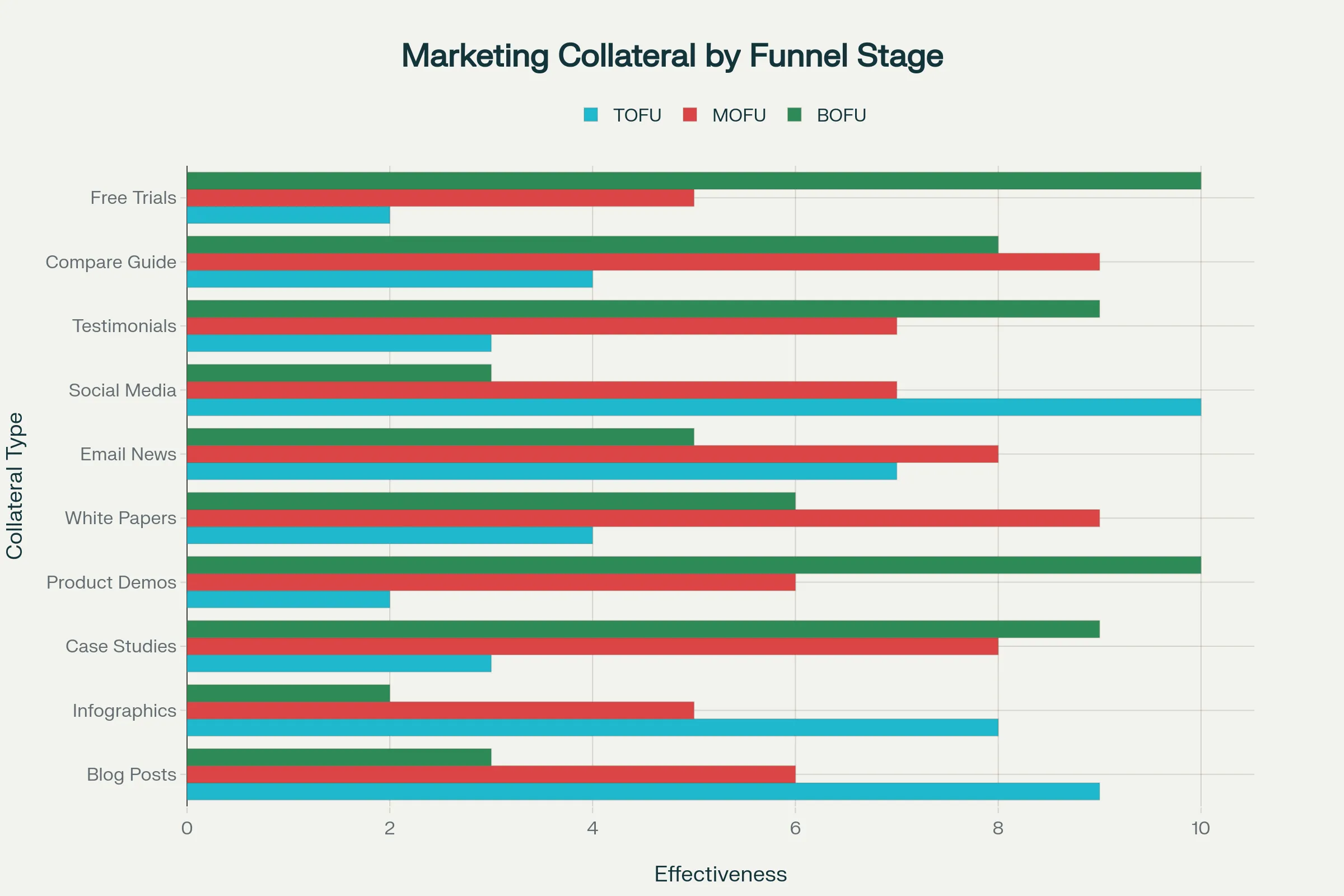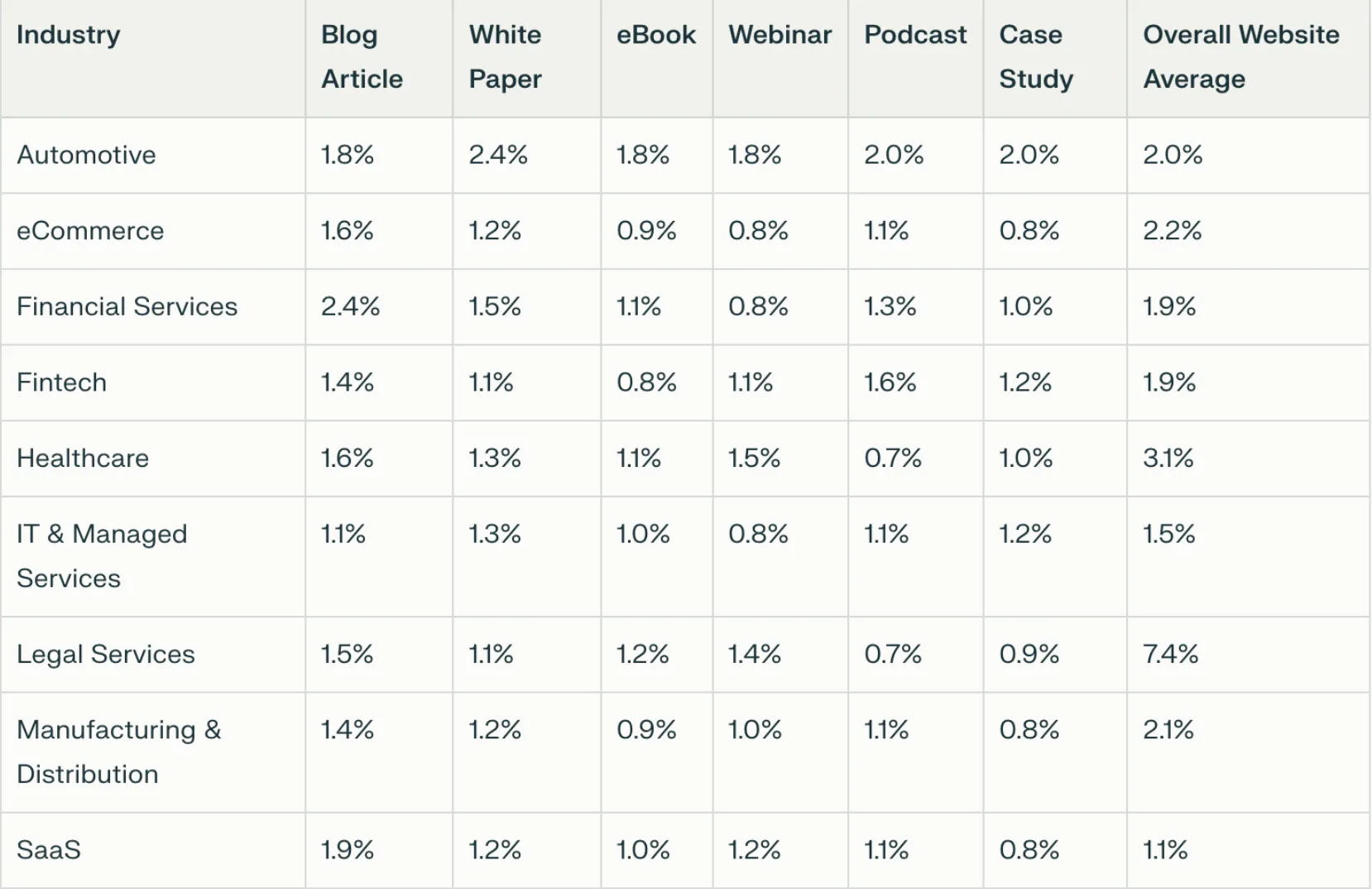The Ultimate Guide to Creating a High-Impact Marketing Collateral Strategy

Every month, marketing teams around the world spend millions creating beautiful brochures, compelling case studies, and engaging videos. Yet, leads don’t convert, the sales team complains collaterals don’t resonate with prospects, and marketing budgets keep growing while results stagnate.
The sobering reality? Most businesses waste up to 90% of their marketing collateral budget on collaterals that don’t align with their goals or customer journey. This isn’t just inefficiency—it’s a massive leak in the revenue pipeline that’s costing businesses billions in wasted resources and missed opportunities.
So what separates industry leaders from the pack? It’s not about having more marketing materials. It’s having the right collateral deployed at the right moments in your customer journey. Companies that strategically align their collateral see 49% win rates on forecasted deals compared to 42.5% for those that don’t.
This comprehensive guide will transform how you approach marketing collateral—from scattered creation to strategic, data-driven deployment. You’ll discover the exact frameworks that top-performing companies use to ensure every piece of marketing material serves a specific purpose, targets a defined audience, and contributes measurably to business growth.
Understanding High-Impact Marketing Collaterals
Marketing collateral represents any branded content or material (physical or digital) used to promote products, services, or values. But not all collaterals are created equal. High-impact marketing collaterals share three critical characteristics:
- Strategic Alignment: They serve specific business goals at defined stages of your customer journey.
- Measurable Performance: They generate trackable results that can be attributed to revenue outcomes.
- Resource Efficiency: They deliver maximum ROI relative to creation and distribution costs.
The difference between generic and high-impact collateral is like comparing a scattershot approach to laser-focused precision. Generic collaterals try to be everything to everyone. High-impact collaterals solve specific problems for specific people at specific moments in their buying journey.
How to Decide Which Marketing Collaterals to Use Based on Your Goals
Choosing the right marketing collateral starts with understanding where your audience is in the buyer’s journey and what you want them to do next. In every marketing journey, prospects move through three key stages—TOFU (Top of Funnel) for broad awareness, MOFU (Middle of Funnel) for lead generation and nurturing, and BOFU (Bottom of Funnel) for conversion and sales enablement.
Goal 1: Building Awareness and Reach (Top of Funnel)
Primary Objective: Attract prospects who don’t know they have a problem worth solving.
High-Impact Collateral Types:
- Blog Posts: 72% of businesses report that content marketing boosts lead generation, with educational blog content driving the highest organic traffic.
- Infographics: Simplify complex concepts and achieve 3x more social shares than other content types.
- Educational Videos: Landing pages with video see 86% higher conversion rates.
- Social Media Content: Builds brand awareness with 10x effectiveness for reach compared to traditional methods.
Optimal CTAs: “Learn more,” “Discover solutions,” “Watch our guide,” “Get insights”
Success Metrics: Website traffic, social engagement, brand awareness surveys, content consumption time
Practical Use Case:
A slow-living brand published a “How to Slow Down Your Calendar” infographic on Instagram. Within two weeks, the post generated 3,500 saves and drove a 25% uptick in website sessions.
Goal 2: Lead Generation and Nurturing (Middle of Funnel)
Primary Objective: Convert aware prospects into qualified leads while building trust and authority.
High-Impact Collateral Types:
- Case Studies: 58% of B2B marketers credit content marketing for generating sales and revenue, with case studies being among the most persuasive formats.
- White Papers: Generate leads at 1.2-1.9% conversion rates across industries.
- Comparison Guides: Help prospects evaluate solutions and position your offering favorably.
- Webinars: Deliver 1.5-2.5% conversion rates while establishing thought leadership.
Optimal CTAs: “Download our guide,” “Get your free consultation,” “Register for webinar,” “Access the toolkit”
Success Metrics: Lead quality scores, email engagement rates, MQL to SQL conversion, nurture sequence performance
Practical Use Case:
A productivity coach offered a gated “2026 Gentle Productivity Guide” PDF. By requiring an email for download, they tripled their email list in one month with a 1.8% download-to-lead conversion rate.
Goal 3: Conversion and Sales Enablement (Bottom of Funnel)
Primary Objective: Convert ready-to-buy prospects into customers by removing final objections.
High-Impact Collateral Types:
- Product Demonstrations: Drive the highest conversion rates, often 10/10 effectiveness for purchase decisions.
- Customer Testimonials: Provide social proof that reduces purchase anxiety.
- Pricing Sheets and ROI Calculators: Address budget concerns directly.
- Free Trials and Samples: Companies investing in sales enablement see 6-20% increases in sales.
Optimal CTAs: “Start your free trial,” “Get pricing,” “Schedule a demo,” “Contact sales,” “Buy now”
Success Metrics: Conversion rates, sales cycle length, deal size, customer acquisition cost
Practical Use Case:
A template provider included an embedded ROI calculator in their proposal template. Prospects could plug in their own metrics and instantly see a projected 350% return, accelerating sign-ups by 22%.

ROI Formula and Performance Benchmarks
Simple ROI Calculation Formula
To quantify the profitability of any marketing collateral, use the basic ROI formula:
ROI = (Revenue Generated − Marketing Investment) / Marketing Investment × 100
Example: If you spend $1,000 on creating case studies and they generate $5,000 in revenue, your ROI is: ($5,000 − $1,000) / $1,000 × 100 = 400%
Advanced ROI Considerations
1. Customer Lifetime Value (CLV)
What it is:
The total revenue a customer brings in over their entire relationship with your brand.
How to calculate:
CLV = Average Purchase Value × Average Purchase Frequency × Average Customer Lifespan
Practical tip: Use CLV to prioritize collateral that attracts high-value customers. For example, invest more in case studies if your CLV is high—small increases in conversion yield big returns.
2. Simple Multi-Touch Attribution
What it is:
A way to credit every piece of collateral a prospect interacts with before purchase, rather than only the first or last touch.
How to implement:
Set up UTM parameters for every asset link.
Use your analytics or CRM’s “linear attribution” model to assign equal credit across all touchpoints.
Practical tip: Identify which collateral types show up most often across winning deals, then allocate budget accordingly.
3. Time-Adjusted ROI
What it is:
An ROI calculation that accounts for how long it takes to see returns, ensuring you’re comparing fast-payoff tactics fairly against longer-term investments.
How to calculate:
Time-Adjusted ROI = ROI / Payback Period in Months
Practical tip: If an email campaign yields 200% ROI over 2 months, its time-adjusted ROI is 100% per month. Compare this to a white paper that yields 400% over 8 months (50% per month) to decide where to invest first.
By tracking CLV, implementing simple multi-touch attribution, and adjusting ROI for time, you’ll make smarter, data-backed decisions about which marketing collateral to create and promote.
Industry-Specific Conversion Benchmarks by Collateral Type

Source: First Page Sage B2B Content Marketing Conversion Rates Report
How to Track and Measure ROI for Each Asset
1. Set Clear Goals and KPIs
Define primary metric (e.g., form fills for gated content, click-through rate for emails).
Map KPIs to the funnel stage (TOFU, MOFU, BOFU).
2. Implement Tracking Mechanisms
Use UTM parameters on links to attribute traffic and conversions accurately.
Configure goals in your analytics platform (e.g., Google Analytics):
– Destination goals (thank-you pages) for downloads, sign-ups
– Event goals for video plays or CTA clicks
3. Leverage CRM and Attribution Models
Integrate marketing collateral touchpoints into your CRM to connect leads to revenue outcomes.
Apply multi-touch attribution to understand how each piece contributes across the buyer’s journey.
4. Calculate and Report ROI
Pull total revenue influenced by each asset (e.g., using revenue attribution reports in your CRM).
Deduct total cost of collateral creation and distribution (design, copywriting, paid promotion).
Apply the ROI formula for each collateral piece and compare against benchmarks.
5. Continuous Optimization
- A/B test headlines, formats, and CTAs
- Review performance monthly, and pivot budget toward top-performing assets.
- Sunset or rework collateral falling below 80% of benchmark metrics.
By consistently applying these formulas, benchmarks, and tracking practices, you’ll transform marketing collateral from cost centers into measurable revenue drivers—enabling data-backed decisions and maximizing ROI across your entire content portfolio.
Step-by-Step Strategic Implementation
Step 1: Conduct a Comprehensive Collateral Audit
Inventory Assessment:
- Catalog all existing marketing materials by type, creation date, and performance metrics
- Identify outdated materials (anything over 6-12 months old requires review)
- Audit frequency recommendation: Every 3-6 months for active campaigns, annually for stable operations
Performance Evaluation:
- Track key metrics: Engagement rates, conversion rates, lead quality scores, revenue attribution
- Identify top performers: 76% of traffic often comes from just 20% of content
- Flag underperformers: Materials with below-industry-average conversion rates
Step 2: Map Collateral to Customer Journey Stages
Journey Stage Analysis:
- Awareness (TOFU): 40-50% of collateral should focus on education and problem identification
- Consideration (MOFU): 30-35% should build trust and demonstrate expertise
- Decision (BOFU): 15-25% should remove purchase objections and facilitate transactions
Gap Identification:
- Where do prospects drop off most frequently?
- Which stages lack sufficient supporting materials?
- What competitive advantages aren’t being highlighted?
Step 3: Prioritize High-ROI Collateral Creation
Resource Allocation Framework:
- Direct Engagement Channels: Focus on personalized, one-to-one communications that consistently deliver strong returns and foster ongoing relationships.
- Evergreen Content: Invest in content that compiles educational insights to build lasting organic traffic and authority over time.
- Proof-Driven Assets: Prioritize case studies, testimonials, and customer success stories that validate your offering’s value and overcome final purchase objections.
Quality Over Quantity Approach:
- Focus principle: 10 exceptional pieces outperform 50 mediocre ones
- Content winner identification: Scale successful formats rather than creating new ones
- Repurposing strategy: Transform one piece into multiple formats (blog → infographic → social posts → email series)
Step 4: Implement Measurement and Testing Systems
Essential Tracking Setup:
- UTM parameters: Track collateral performance across channels
- Goal configuration: Set up conversion tracking in Google Analytics
- CRM integration: Connect marketing materials to sales outcomes
A/B Testing Protocol:
- Test variables: Headlines, CTAs, formats, distribution timing
- Statistical significance: Ensure adequate sample sizes before declaring winners
- Continuous optimization: Continually refining your efforts based on key performance metrics
Step 5: Scale and Optimize Based on Data
Performance Review Cycles:
- Weekly: Monitor high-activity campaigns and immediate performance indicators
- Monthly: Analyze conversion trends and budget allocation effectiveness
- Quarterly: Comprehensive ROI assessment and strategic adjustments
Scaling Strategies:
- Double down on winners: Increase investment in highest-performing collateral types
- Eliminate losers: Remove or dramatically improve underperforming materials
- Cross-channel promotion: Amplify successful content across multiple touchpoints
Common Pitfalls and How to Avoid Them
Pitfall 1: Creating Generic, Purpose-Less Content
The Problem: 50% of prospect engagement comes from just 10% of content, indicating most materials lack strategic focus.
The Solution:
- Define specific objectives for each piece before creation begins
- Target persona-specific pain points rather than generic industry topics
- Align content format with intended business outcome
Implementation Tip: Use a content brief template that mandates: target persona, business goal, success metrics, and distribution strategy.
Pitfall 2: Misaligned Funnel-Stage Targeting
The Problem: Using awareness-stage content for ready-to-buy prospects, or overwhelming early-stage visitors with product details.
The Solution:
- Map user intent to content types using keyword research and behavioral data
- Create stage-specific content libraries organized by funnel position
- Implement progressive disclosure where early-stage visitors can access deeper information as needed
Performance Impact: Companies with sales enablement teams are 52% more likely to have sales processes aligned with the buyer’s journey.
Pitfall 3: Neglecting Performance Measurement
The Problem: Only 36% of marketers can accurately measure ROI, leading to continued investment in ineffective materials.
The Solution:
- Implement comprehensive tracking from first touch to final conversion
- Use attribution modeling to understand multi-touch customer journeys
- Regular performance reviews with clear success/failure criteria
Tools and Templates: Utilize ROI tracking templates and dashboard systems to automate measurement processes.
Pitfall 4: Outdated Materials Damaging Brand Credibility
The Problem: Marketing collateral can become outdated quickly, with old pricing, product features, or company information confusing prospects.
The Solution:
- Implement content lifecycle management with clear expiration dates
- Quarterly update cycles for data-driven content
- Version control systems to ensure teams use current materials
Brand Consistency Check: Ensure logos, color schemes, and messaging remain consistent across all materials.
How Professional Templates Can Accelerate Your Success
Creating high-impact marketing collateral from scratch is time-intensive and requires significant design expertise. Professional template solutions can dramatically reduce your time-to-market while ensuring brand consistency and optimal performance.
Strategic Template Benefits
Time Efficiency: Pre-designed templates eliminate the need to start from zero, reducing creation time by 60-80%.
Professional Quality: Access to designs created by experts ensures materials meet industry standards and aesthetic expectations.
Brand Consistency: Template systems maintain visual coherence across all materials, strengthening brand recognition.
Conversion Optimization: Templates designed with proven conversion principles incorporate optimal layouts, typography, and CTA placement.
Cost Effectiveness: Template investments provide better ROI than custom design for each individual piece, especially for smaller businesses or teams with limited budgets.
Scalability: Once you have template systems in place, creating new materials becomes a simple customization process rather than a complete redesign project.
Popular Template Categories for Maximum Impact
- Lead Generation Templates: Landing pages, opt-in forms, lead magnets
- Sales Enablement Materials: Proposal templates, pricing guides, comparison sheets
- Content Marketing Assets: Blog post templates, social media templates, email designs
- Brand Identity Systems: Logo variations, color palettes, typography guides
By leveraging professionally-designed templates, businesses can focus their energy on strategy and content creation rather than design execution, leading to more consistent output and better resource allocation.
Your Next Steps to Marketing Collateral Mastery
The transformation from scattered marketing efforts to strategic, ROI-driven collateral begins with acknowledging a fundamental truth: every piece of marketing material should serve a specific purpose, target a defined audience, and contribute measurably to your business goals.
With the frameworks, formulas, and strategies outlined in this guide, you now have the tools to join the top tier of marketing organizations that view collateral as a strategic asset rather than a necessary expense.
Remember, quality outperforms quantity. Embrace a strategic mindset around your marketing collateral, and watch how every piece begins to pull its weight in contributing to your business success.